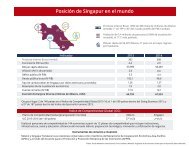basic-guide-to-exporting_Latest_eg_main_086196
basic-guide-to-exporting_Latest_eg_main_086196
basic-guide-to-exporting_Latest_eg_main_086196
You also want an ePaper? Increase the reach of your titles
YUMPU automatically turns print PDFs into web optimized ePapers that Google loves.
All U.S. businesses have many ways <strong>to</strong> compete in international markets, including:• How the product is positioned in a specific market• The advantage of the “Made in the USA” brand• Help from the GEE, including government export promotion services• Excellent cus<strong>to</strong>mer service or some other competitive advantage that has little <strong>to</strong> do withwhat is being sold but how it’s sold• Free trade agreements or foreign currency exchange fluctuations that cause competi<strong>to</strong>rs’products <strong>to</strong> be more expensiveFinally, your product may have export potential even if sales are declining in the U.S. market.Sizable export markets may still exist, especially if the product once did well here but is nowlosing market share <strong>to</strong> more technically advanced products. Other countries may not need stateof-the-arttechnology and may be unable <strong>to</strong> afford more sophisticated and expensive products.Assessing Your Company’s Export ReadinessExport-ready companies possess certain qualities that increase the likelihood that their <strong>exporting</strong>efforts will be successful. Answering these important questions about how <strong>exporting</strong> will enhanceyour company’s goals can help you determine your company’s export readiness:• What does your company want <strong>to</strong> gain from<strong>exporting</strong>?• Is <strong>exporting</strong> consistent with other company goals?• What demands will <strong>exporting</strong> place on yourcompany’s key resources, management andpersonnel, production capacity, and financing, andhow will these demands be met?• Are the expected benefits worth the costs, or wouldcompany resources be better used for developingnew domestic business?For a more in-depth assessment of whether yourcompany is ready <strong>to</strong> export, it’s a good idea <strong>to</strong> take theexport readiness assessment, available atexport.gov/b<strong>eg</strong>in/assessment.asp. You’ll be asked<strong>to</strong> consider issues such as your company’s curren<strong>to</strong>perations, attitudes, and products.Qualities of an Export-Ready Company• Have commitment from ownership and areprepared <strong>to</strong> fund <strong>exporting</strong> activities• Understand the added demands internationalbusiness can place on key resources• Have realistic expectations r<strong>eg</strong>arding return oninvestment from international activities• Are prepared <strong>to</strong> modify products and servicesby market as well as provide training andafter-sales service• Be willing <strong>to</strong> work with government exportpromotion agenciesFor a more theoretical assessment, it is helpful <strong>to</strong> examine some of the motivational andorganizational fac<strong>to</strong>rs behind your company’s decision <strong>to</strong> export. Thinking about these fac<strong>to</strong>rs willhelp you decide if your company and your product are ready <strong>to</strong> export.Chapter 2: Developing an Export Strat<strong>eg</strong>y15





